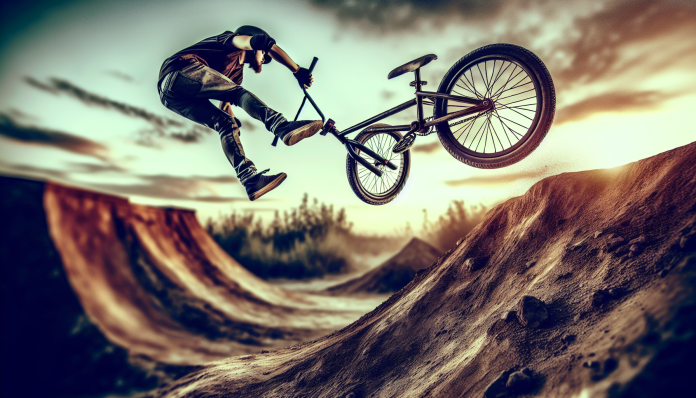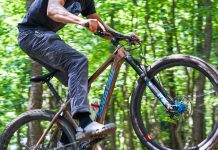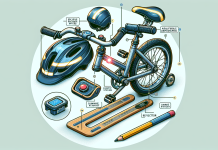If you’re looking for an adrenaline-fueled adventure on two wheels, BMX bikes are the way to go. From the thrill of soaring through the air on dirt jumps to the excitement of nailing jaw-dropping trick combinations, these nimble machines have become synonymous with extreme sports. In this article, we’ll take you on a wild ride exploring the heart-pounding world of BMX bikes, where riders push their limits and defy gravity with every pedal stroke. Get ready to witness the unbridled passion and sheer skill of those who choose to ride on the edge of what’s possible.
Table of Contents
History of BMX Bikes
Origin of BMX
The origin of BMX bikes can be traced back to the late 1960s and early 1970s in Southern California. At that time, children and teenagers who were passionate about racing their bicycles on dirt tracks started to modify their bikes to make them more suitable for off-road racing. These modified bikes quickly became known as “BMX” bikes, which stands for Bicycle Motocross.
Growth and Evolution of BMX Bikes
As the popularity of BMX racing grew, manufacturers started to take notice and began producing specialized BMX bikes. The first commercially available BMX bike was the Schwinn Sting-Ray, introduced in 1970. This bike was specifically designed for off-road racing, with features such as a sturdy frame, knobby tires, and a single-speed drivetrain.
Over the years, BMX bikes continued to evolve with advancements in technology and the demands of riders. The 1980s saw the introduction of chromoly steel frames, which were lighter yet stronger than the previous steel frames. This allowed riders to perform more complex tricks and stunts without sacrificing durability.
Influence of Motocross on BMX
Motocross, a form of motorcycle racing on off-road tracks, had a significant influence on the development of BMX bikes. Many BMX riders were also avid motocross fans and drew inspiration from the high-speed, adrenaline-fueled sport. They incorporated motocross techniques and styles into their BMX riding, which contributed to the development of new tricks and riding styles.
Introduction of Freestyle BMX
In the late 1970s and early 1980s, a new aspect of BMX riding emerged – freestyle. Freestyle BMX involved performing tricks and stunts on various obstacles such as ramps, curbs, and ledges. This new style of riding paved the way for the sport to branch out beyond just racing and into an exciting world of creativity and self-expression.
Types of BMX Bikes
Dirt Jump BMX Bikes
Dirt jump BMX bikes are specifically designed for jumping and performing tricks on dirt jumps. They typically have a smaller frame size for increased maneuverability and short chainstays for better handling in the air. Dirt jump bikes also feature knobby tires for traction on loose surfaces and a strong, lightweight frame built to withstand the impact of landings.
Street BMX Bikes
Street BMX bikes are designed for riding in urban environments such as streets, plazas, and skateparks. They are built to handle the demands of stair sets, ledges, and other street obstacles. Street BMX bikes often have a longer frame and top tube for stability and a stronger build to withstand the abuse of grinds and hard landings.
Park BMX Bikes
Park BMX bikes are specifically designed for riding in skateparks and other concrete or wooden park environments. These bikes typically have a shorter wheelbase and smaller frame size for increased maneuverability and responsiveness. Park BMX bikes come equipped with smooth tires and a lightweight build to enhance control and allow riders to perform technical tricks.
Flatland BMX Bikes
Flatland BMX bikes are designed for performing intricate tricks and maneuvers on flat surfaces. They have a unique frame geometry with a lower standover height to provide clearance for leg movement during spinning and balancing tricks. Flatland BMX bikes also often feature a smaller wheel size for increased agility and control.
Racing BMX Bikes
Racing BMX bikes are built for speed and competition on dedicated BMX race tracks. These bikes are lightweight and streamlined, with a larger frame size to provide stability at high speeds. Racing BMX bikes feature high-pressure tires, a single-speed drivetrain, and powerful brakes to ensure maximum efficiency and control on the racetrack.
Components of a BMX Bike
Frame
The frame is the core component of a BMX bike, providing the structure and support for all other components. BMX frames are typically made of steel, aluminum, or chromoly, with each material offering its own benefits in terms of strength, weight, and stiffness. The frame’s geometry, including the top tube length, head angle, and seat tube angle, plays a crucial role in the bike’s handling characteristics.
Fork
The fork connects the front wheel to the frame and absorbs impacts from uneven terrain. BMX forks are typically made of steel or chromoly and come in different designs, including traditional forks and suspension forks for certain riding styles. The fork’s offset, which determines the distance between the wheel and the steering axis, greatly affects the bike’s responsiveness and stability.
Handlebars
Handlebars are essential for steering and controlling the bike. BMX handlebars come in various shapes and sizes, with different widths and rises to accommodate individual rider preferences. The most common types of BMX handlebars are the traditional 2-piece and 4-piece bars, known for their durability and versatility.
Cranks
The cranks, attached to the bottom bracket of the frame, transfer rider pedaling power to the drivetrain. BMX cranks are typically made of chromoly or aluminum and come in different lengths to suit rider preferences and riding styles. The crankset also includes the sprocket, which is connected to the cranks and powers the chain.
Sprocket and Chain
The sprocket is a toothed wheel that is connected to the crankset and powers the chain. BMX sprockets come in various sizes, with larger sprockets providing more speed and smaller sprockets offering more torque. The chain connects the sprocket to the rear wheel’s freewheel or cassette, allowing the rider to pedal and propel the bike forward.
Wheels and Tires
BMX wheels are designed to withstand the demands of trick riding and racing. They are typically made of lightweight yet durable materials such as aluminum or magnesium alloy. BMX tires vary in tread pattern and width, with knobby tires providing traction for off-road riding and smoother tires offering lower rolling resistance for park and street riding.
Brakes
Brakes are an essential safety feature on BMX bikes, allowing riders to control their speed and come to a stop when needed. BMX bikes can have either a U-brake or a caliper brake, with some riders opting for a brakeless setup for certain riding disciplines. Brake systems typically include a lever, cable, and brake pads.
Pedals
Pedals are what the rider’s feet rest on and provide the means to transfer power to the bike. BMX pedals need to be durable and grippy to withstand the forces of trick riding and racing. Platform pedals are the most common type of BMX pedals, with some riders opting for pedals with pins for increased traction.
Seat and Seatpost
The seat and seatpost provide the rider with a comfortable seating position and adjustability. BMX seats are typically minimalistic and lightweight, allowing for a greater range of movement during tricks and jumps. The seatpost connects the seat to the frame and can be adjusted in height to suit the rider’s preference.
Dirt Jumping
Definition and Purpose
Dirt jumping is a discipline of BMX riding that involves jumping and performing tricks on specially built dirt jumps and berms. The purpose of dirt jumping is to showcase acrobatic skills and control while soaring through the air and landing smoothly. It requires a combination of balance, timing, and confidence to execute jumps and tricks successfully.
Construction of Dirt Jumps
Dirt jumps are meticulously constructed by skilled riders and builders. They are built using shovels and other hand tools to shape the dirt into jump lips (takeoff ramps), landings, and transition sections. Dirt jumps require careful attention to detail, ensuring the proper angle and height for maximum airtime and a safe landing.
Types of Dirt Jumps
Dirt jumps come in various shapes and sizes, each designed to cater to different riding preferences and skill levels. The most common types of dirt jumps include tabletop jumps, in which the landing is separated from the takeoff by a flat section, and doubles, where the takeoff and landing are directly connected.
Advanced riders may also tackle more complex jumps, such as step-up jumps, step-down jumps, and gap jumps, which require precise speed and maneuvering to clear.
Skills and Techniques in Dirt Jumping
Successfully navigating dirt jumps requires a combination of technical skills and physical ability. Riders must have a solid understanding of timing, speed management, and body positioning to achieve maximum height and distance. Proper technique in the approach, takeoff, and landing is crucial for a smooth and controlled flight through the air.
Safety Precautions in Dirt Jumping
Safety should be a top priority when participating in dirt jumping. Riders should always wear appropriate safety gear, including a helmet, knee and elbow pads, and gloves, to protect against potential injuries. It is also important to warm up and stretch before riding, as the physical demands of dirt jumping can put strain on the body. A well-maintained bike should be regularly inspected to ensure that all components are in working order and able to withstand the impact of landings. Lastly, riders should always be cautious of their surroundings and avoid attempting jumps beyond their skill level to minimize the risk of accidents.
Freestyle Trick Riding
Introduction to Freestyle Trick Riding
Freestyle trick riding is a dynamic and creative discipline of BMX riding that involves performing various tricks and stunts on a variety of obstacles such as ramps, rails, and ledges. Unlike other forms of BMX riding, which focus on speed or racing, freestyle trick riding is all about pushing the limits of what is possible on a BMX bike and expressing one’s individual style through their riding.
Types of Tricks in Freestyle BMX
Freestyle BMX tricks can be categorized into various types, each requiring different skills and techniques. Some common types of freestyle tricks include:
- Aerial Tricks: These tricks involve getting airborne and performing maneuvers such as spins, flips, and whips.
- Grinds and Slides: Grinds involve sliding the bike’s pegs or tires on a rail or ledge, while slides involve using the frame or wheels to skim along a surface.
- Manuals and Wheelies: These tricks involve balancing on either the front or rear wheel while riding at a slow speed.
- Stalls and Lip Tricks: Stalls involve bringing the bike to a stop on an obstacle or ramp and balancing in place, while lip tricks are performed on the coping of a quarterpipe or ramp.
- Combination Tricks: Combination tricks involve linking multiple tricks together in a sequence to create a routine or line.
Basic Tricks
Basic freestyle tricks are the building blocks of more advanced maneuvers. These tricks include simple jumps, manual wheelies, and basic grinds or slides. Mastering these basic tricks provides a solid foundation for progressing to more complex and challenging tricks.
Intermediate Tricks
Intermediate freestyle tricks involve a higher level of difficulty and technical skill. These include more complex aerial tricks such as 360 spins, tailwhips, and barspins. Intermediate riders may also start to experiment with more technical grinds, slides, and stalls on various obstacles.
Advanced Tricks
Advanced freestyle tricks push the boundaries of what is physically possible on a BMX bike. These tricks require advanced bike control, spatial awareness, and a high level of confidence. Some examples of advanced tricks include backflips, double tailwhips, and complex combination maneuvers like flair whips and decade airs.
Park and Street Riding
Freestyle trick riding can be done in various settings, with two primary categories being park riding and street riding. Park riding involves performing tricks on ramps, halfpipes, and other designated park features. Street riding, on the other hand, takes place in urban environments such as streets, plazas, and skateparks, with riders utilizing ledges, stairs, and other architectural elements for tricks.
Safety Gear for Freestyle Trick Riding
When engaging in freestyle trick riding, it is crucial to prioritize safety. Wearing a helmet is paramount to protect against head injuries. Additional safety gear, such as knee and elbow pads, wrist guards, and shin guards, can provide further protection against scrapes, fractures, and other injuries. It is also essential to ride within one’s skill level and gradually progress to more challenging tricks to minimize the risk of accidents.
BMX Events and Competitions
X Games
The X Games is one of the most prestigious and widely recognized action sports events in the world. It showcases a variety of extreme sports, including BMX freestyle, in which riders compete in disciplines such as park, street, and dirt jumping. The X Games brings together the best BMX riders from around the globe to compete for medals and showcase their skills in front of a global audience.
Dew Tour
The Dew Tour is a multi-sport event that features skateboarding, snowboarding, and BMX competitions. The BMX competitions include park and dirt events, attracting top riders from different disciplines. The Dew Tour is known for its innovative courses and progressive setups, providing a platform for riders to showcase their technical skills and creativity.
FISE World Series
The FISE World Series is an international action sports festival that includes BMX freestyle as one of its main disciplines. The series consists of several events held in different countries throughout the year, where riders compete for overall rankings. The FISE World Series showcases a variety of BMX disciplines, including park, street, and flatland riding, and draws top riders from all over the world.
UCI BMX Freestyle Park World Cup
The UCI BMX Freestyle Park World Cup is a series of international competitions sanctioned by the Union Cycliste Internationale (UCI). These events feature world-class BMX park riding, with riders competing for ranking points and a chance to qualify for major international events, including the Olympics. The UCI BMX Freestyle Park World Cup is a platform for riders to showcase their skills and attract attention from sponsors and fans.
Red Bull Rampage
While primarily known for its mountain biking events, Red Bull Rampage also features a freestyle BMX competition. Red Bull Rampage takes place in the desert environment of Utah and is known for its massive jumps and high-risk lines. The competition challenges riders to push the limits of what is possible on their BMX bikes, with breathtaking drops, flips, and tricks that leave spectators in awe.
Famous BMX Riders
Mat Hoffman
Mat Hoffman, often referred to as the “Condor,” is a legendary BMX rider known for his groundbreaking tricks and contributions to the sport. He is credited with inventing numerous tricks, including the first no-handed 900 spin. Hoffman is a pioneer of both dirt jumping and vert riding, and his passion for pushing the limits of what can be done on a BMX bike has inspired countless riders.
Dave Mirra
Dave Mirra was an icon in the world of BMX freestyle. He holds the record for the most X Games medals won in BMX disciplines, with a total of 24 medals, including 14 golds. Mirra’s riding style, characterized by his smoothness, versatility, and progressive tricks, set the bar for what was possible in BMX competition. His tragic passing in 2016 was a tremendous loss to the BMX community.
Jamie Bestwick
Jamie Bestwick is a dominant rider in the BMX vert discipline. He is a record-breaking 14-time X Games gold medalist and has firmly established himself as one of the greatest riders in the history of the sport. Bestwick’s ability to perform complex tricks with precision and consistency has made him a respected figure in the BMX community.
Chad Kagy
Chad Kagy is a versatile BMX rider known for his skills in multiple disciplines, including park and dirt jumping. He is a three-time X Games gold medalist and has consistently ranked among the top riders in various competitions. Kagy’s fearless riding style and technical proficiency have earned him recognition as one of the top athletes in BMX.
Nigel Sylvester
Nigel Sylvester is a street BMX rider known for his unique style and creative approach to riding. He gained widespread recognition through his series of “Go!” videos, which showcase his ability to seamlessly blend BMX riding with urban culture and exploration. Sylvester’s influence extends beyond the realm of competition, as he continues to inspire riders around the world with his innovative street riding and global adventures.
Popular BMX Parks and Trails
Woodward BMX Park
Woodward BMX Park is a world-renowned training facility located in Pennsylvania, USA. It offers a variety of outdoor and indoor ramps, jumps, and obstacles designed for all skill levels. Woodward is a mecca for BMX riders, providing them with a safe and controlled environment to practice their skills and progress their riding.
Skatepark of Tampa
Skatepark of Tampa, located in Florida, USA, is a popular destination for riders looking to test their skills on a wide range of skatepark features. The park offers a mix of street obstacles, ramps, and ledges, catering to both park and street riding styles. With a vibrant atmosphere and a supportive community, Skatepark of Tampa is a favorite spot for BMX riders of all levels.
Vans Skatepark
Vans Skatepark, located in California, USA, is a premier facility for BMX riders and skateboarders alike. The park features a diverse range of ramps, bowls, and street-inspired obstacles, providing riders with endless possibilities for creative lines and tricks. Vans Skatepark is not only a great place to ride but also hosts various events and competitions, further fostering the BMX community.
Joyride 150
Joyride 150, situated in Ontario, Canada, is one of the largest indoor bike parks in North America. With over 100,000 square feet of riding space, including ramps, jumps, and foam pits, Joyride 150 offers riders an all-weather facility to hone their skills and have fun. The park caters to both BMX riders and mountain bikers, providing various lines and features for different riding styles.
Incline Club
Incline Club, located in New Jersey, USA, is a popular destination for BMX riders seeking a challenging and diverse riding experience. The park offers a mix of ramps, bowls, and street obstacles, providing riders with endless opportunities to progress and learn new tricks. Incline Club also hosts events and competitions, contributing to the vibrant BMX scene in the region.
BMX Culture and Community
BMX Magazines and Media
BMX magazines and media play an important role in documenting and promoting the BMX culture and community. These publications and digital platforms feature rider interviews, event coverage, product reviews, and riding tips, providing a valuable resource for riders of all levels. BMX media also highlights the creativity, style, and progression within the sport, helping to inspire and connect riders around the world.
Online BMX Communities
Online BMX communities have become a significant aspect of the BMX culture, allowing riders to connect, share content, and discuss all things related to BMX. Online forums, social media groups, and dedicated BMX websites provide a platform for riders to seek advice, share experiences, and showcase their riding. These communities foster a sense of camaraderie and encourage the growth of the BMX community worldwide.
BMX Fashion and Style
BMX fashion and style have become an integral part of the sport’s culture. Riders often express their individuality through their clothing choices, embracing a mix of streetwear, athletic apparel, and BMX-specific brands. The BMX fashion scene is a reflection of the sport’s diverse influences, combining elements of urban street style with functional riding gear.
BMX Crews and Teams
BMX crews and teams play a crucial role in fostering a sense of community and collaboration within the sport. Crews are groups of riders who come together to ride, film videos, and support one another’s progression. Teams, on the other hand, are often sponsored groups of riders who represent specific brands or bike companies, competing in events and promoting their sponsors. Both crews and teams contribute to the vibrancy and camaraderie of the BMX community.
Safety Tips for BMX Riding
Wear a Helmet
Wearing a helmet is the most important safety precaution for BMX riding. A properly fitted helmet can protect the rider’s head in the event of a fall or collision, reducing the risk of severe head injuries. It is essential to use a BMX-specific helmet that meets safety standards and has a secure fit.
Protective Gear
In addition to a helmet, riders should consider wearing additional protective gear such as knee and elbow pads, gloves, and shin guards. This gear can help prevent injuries, especially when attempting more challenging tricks or riding on technical terrain. Protective gear should fit comfortably and be securely fastened to ensure effective protection.
Inspect Your Bike
Before each ride, it is important to inspect your BMX bike to ensure that all components are in good working condition. Check the brakes, tires, chain, pedals, and other parts for any signs of wear or damage. Make sure all bolts are tightened securely, and the wheels are properly aligned. Regular maintenance and inspections can help prevent accidents caused by mechanical failures.
Choose Suitable Riding Areas
Selecting appropriate riding areas is crucial for safety. Riders should choose areas that are specifically designated for BMX riding, such as skateparks or bike parks, where the obstacles and riding conditions are designed for BMX bikes. Riding in organized and controlled environments reduces the risk of collisions with pedestrians, vehicles, or other obstacles that can be present in public spaces.
Learn and Progress Safely
Riders should always ride within their skill level and gradually progress to more advanced tricks and maneuvers. Learning the proper technique for each trick and practicing it in controlled environments, such as foam pits or resi ramps, can help build confidence and reduce the risk of injury. It is important to never attempt tricks or maneuvers beyond one’s capabilities, as this can lead to accidents and injuries.
By following these safety tips, riders can enjoy their BMX experience while minimizing the risk of injuries. Safety should always be a top priority, allowing riders to pursue their passion and progress their skills in a safe and controlled manner.





































